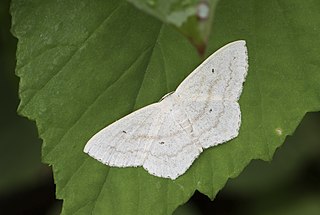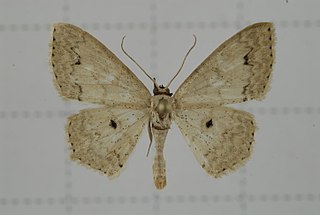
The geometer moths are moths belonging to the family Geometridae of the insect order Lepidoptera, the moths and butterflies. Their scientific name derives from the Ancient Greek geo γεω, and metron μέτρον "measure" in reference to the way their larvae, or "inchworms", appear to "measure the earth" as they move along in a looping fashion. A very large family, it has around 23,000 species of moths described, and over 1400 species from six subfamilies indigenous to North America alone. A well-known member is the peppered moth, Biston betularia, which has been subject of numerous studies in population genetics. Several other geometer moths are notorious pests.

The cream wave is a moth of the family Geometridae. The species was first described by Adrian Hardy Haworth in 1809. It is found in forest and woodland regions, feeding on grasses and small plants such as dandelion.

Scopula immutata, the lesser cream wave, is a moth of the family Geometridae. It was described by Carl Linnaeus in his 1758 10th edition of Systema Naturae. It is found throughout Europe.

Scopula cacuminaria, the frosted tan wave, is a moth of the family Geometridae. The species was first described by Herbert Knowles Morrison in 1874. It is found in North America across southern Canada, from the Maritimes to southern British Columbia, south to Texas.
Scopula adelpharia is a moth of the family Geometridae. It was described by Püngeler in 1894. It is found in North Africa, the Near East and Middle East.
Scopula albiceraria is a moth of the family Geometridae. It was described by Gottlieb August Wilhelm Herrich-Schäffer in 1847. It is found in Transcaucasia and Siberia.
Scopula anoista is a moth of the family Geometridae. It was described by Prout in 1915. It is found in Cameroon, Equatorial Guinea and Ivory Coast.
Scopula bifalsaria is a moth of the family Geometridae. It was described by Prout in 1913. It is endemic to China.
Scopula deflavaria is a moth of the family Geometridae. It is found in Indonesia.
Scopula desita is a moth of the family Geometridae. It is found from Australia to the Sunda Islands, Tenimbar Islands and the Philippines.
Scopula emma is a moth of the family Geometridae. It was described by Prout in 1913. It is found in China and Taiwan.

Scopula flaccidaria is a moth of the family Geometridae. It was described by Zeller in 1852. It is found in the Asia Minor, Russia and south-eastern Europe.
Scopula gastonaria is a moth of the family Geometridae. It was described by Oberthür in 1876. It is endemic to Algeria.
Scopula impersonata is a moth of the family Geometridae. It is found in China, the Russian Far East, Taiwan and Japan.
Scopula infota is a moth of the family Geometridae. It is found in Bolivia and Peru.
Scopula misera is a moth of the family Geometridae. It is found on the Tenimbar Islands and Flores.
Scopula modicaria is a moth of the family Geometridae. It was described by John Henry Leech in 1897. It is found in China, the Russian Far East, Korea and Japan.
Scopula orientalis is a moth of the family Geometridae. It was described by Sergei Alphéraky in 1876. It is found in Bulgaria, North Macedonia, Ukraine, Russia, Turkey and Korea.
Scopula praecanata is a moth of the family Geometridae. It is found in Tibet and central China (Sichuan).

Scopula proximaria is a moth of the family Geometridae. It is found in central China and Taiwan.





